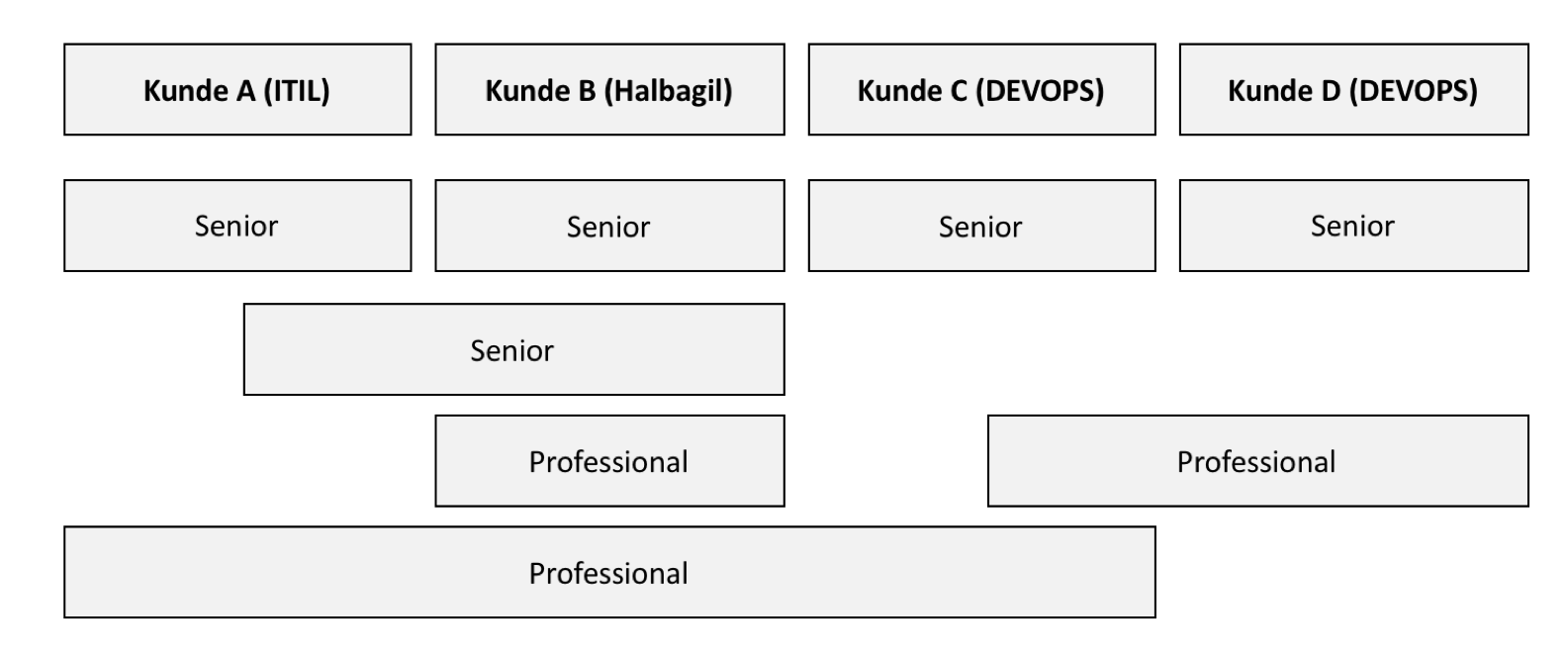For less than 8 months I have been responsible for a small team now consisting of 9 people who work completely virtually at 3 locations for 4 customers who couldn’t be more different. The team can decide for themselves when and how they can work from home and at which of the three locations they want to work. Although each team member lives at one of the three locations, people often commute between the locations. However, our customers are not represented at the locations, which is not important as we work for them remotely. While two customers work more traditionally according to ITIL, the others are based on the DevOps method.
For this team to be successful, a new type of leadership and collaboration is important. In addition to the technical requirements such as VPN and software tools such as Jira and video conferencing, collaboration on a human level was of course an important factor for me, which is discussed in this article.
Four management methods – four customers
In order to support the team as best as possible, I have divided it up according to customers. Every customer has a fixed contact person. This employee only works for this customer. The other 5 employees each work for 1.5 customers. In summary, a customer has a permanent employee as well as a representative.
In order to support this as best as possible, I used four management methods for the four customers. With a customer, I’m more there as a coach for the employee and as an escalation for the customer, if something should happen.
In contrast, I work for a customer, even in day-to-day business, and I am on a perfect eye-level with the customers and technicians in the project. For the third customer, we work according to DevOps and I play the Scrum Master in the team. The fourth customer is new and I can just find my rhythm. For this reason, I can’t say that much yet, because I carefully look at the customer and let the technicians do the work first, as the customer is still superbly guided by the responsible project manager.
Study: Success Factors of Virtual Teams
Akin and Rumpf already examined the success factors of virtual teams in 2013. Together with Tobias Greff from the AWS Institute I have in a study (Lindner and Greff 2018). selected of them examined. The 50 executives with a focus on virtual teams were asked to rate the factors according to importance from 1 (very important) to 5 (not important).
- Mentoring / coaching of team members (2.44 – higher importance)
- Determination of individual and group goals (2.48 – higher importance)
- Definition of roles and tasks (2.56 – average importance)
- Organization of personal meetings of the team to build trust (2.64 – average importance)
- Control and monitoring of team members (4.88 – low importance)
Definition of roles and tasks
My first important task was to define roles and tasks. As already described, some employees are permanently assigned to a customer. These are usually the strong seniors. The professionals each support 2 customers. Thus they are coached extensively by 2 seniors. Below is the organizational chart for the team. Since one customer and the 2 employees are still new, the cross-functional aspect is not yet pronounced for customer D, but that will come soon. I also have the role of “location representative” for each location, which one person permanently assumes. For example, he will book a room etc. for us if we are holding a meeting at a location.

Mentoring / coaching of the team members
The first place in our study was the mentoring of the team members. I also took this to heart in my team. For this reason, I travel back and forth between the locations on a monthly basis and talk to the team and make phone calls to the teams on a daily basis. Individual coaching is also important. For this reason, I telephone every single team member on a weekly basis. But I don’t think that I coach there, I just listen. Now and then I explain what the situation is like at the other location in order to create an understanding. Usually the employee knows better how to act with the customer anyway and usually only needs an open ear.
activities
- Weekly one-on-one meetings
- Daily conference call
- monthly visit
Determination of individual and group goals
Now I’ve set certain goals for the team. On the one hand, I wanted to develop the professionals further and further strengthen the seniors. So I have OKRs (Objective and key results set for customers). OKRS means that a team vision is defined, which is broken down into individual goals for the respective team and individual. These are negotiated democratically with the team. The result is as follows. For the time being we did without the team vision because the team is new and we want to maintain customer satisfaction for the time being.
- Customer A: no complaints and failures (proactive failure management)
- Customer B: Utilization of the hourly quota to the satisfaction of the customer
- Customer C: Achievement of the story points in each month
- Customer D: Release of the new technology in June and proactive maintenance
With the respective jumpers, i.e. who are not directly assigned to a customer, I have agreed that they should learn and help to get the senior title one day. So the goal for everyone was: to become a senior!
activities
- Customer goals negotiated democratically
- The individual goal is always the next career level
Organization of personal meetings of the team to build trust
Another point is of course building trust. With virtual teams in particular, it is always important that the team knows each other and works in harmony. Fortunately, in addition to enough travel budget, I also have a budget for a team evening a month. We usually go out together in the evening and often party extensively well into the night. I think this is an important factor in the success of this team. We also have a 3-4h meeting before the team evening in which we clarify various points.
activities
- Team evening once a month
- Team meeting once a month
Control and monitoring of team members
I’m actually not a fan of surveillance, as I find that it makes employees feel more insecure than encouraging them. I believe that everyone wants to work and that you should just measure the achievement of goals. We have Jira and a ticket system in which I can look up the employees’ tasks for hours. However, I tend to talk to the team in the daily or check the regular telco with the customer to see how satisfied they are. I also tend to make sure that all employees adhere to the customer’s processes (e.g. Scrum). Of course, I also check the ticket system from time to time, but mostly everything is okay there or with so many customers and tickets it is never possible to understand everything in depth anyway.
activities
- Measure goals
- Ask employees
- Customers ask
Open challenges and conclusion
At the time, I took on the challenge of virtual collaboration with pleasure and enjoy working with this team every day and also with and on this way of working. It is completely new to me, too, because in my doctorate I examined virtual leadership rather theoretically, but I was able to start the race with a little prior knowledge. In any case, it is important to cut the tasks clearly on the one hand and to allow overlaps on the other. Furthermore, clear goals and many individual discussions are very beneficial.
For the future, I am now planning to sensibly dock with the new customer and also to develop the seniors in the team into strong executives. Maybe one day you will replace me. Now I would like to face the last task, which is to abolish myself. My vision is that the team will continue to work for the customers in a completely autonomous, virtual and self-organized manner. Until then we still have a long way to go, but we are on the right track.
Reading tip: Organizational rebels – my change story
[werbung] Verwendete Quellen anzeigen
Lindner, D., & Greff, T. (2018). Digital leadership in SMEs: an empirical study from the perspective of executives. currently still in the phase of publication
Akin, N., & Rumpf, J. (2013). Leadership of virtual teams. Group dynamics and organizational consulting , 44 (4), 373-387. https://doi.org/10.1007/s11612-013-0228-9



